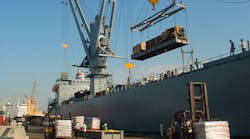Growing imports at the nation’s major retail container ports set an all-time monthly record this summer, and 2017 is expected to reach a new yearly record, according to the monthly Global Port Tracker report recently released by the National Retail Federation and Hackett Associates.
“Consumers are buying more, and retailers are scrambling to import more merchandise to keep up with the demand,” NRF vice president for Supply Chain and Customs Policy Jonathan Gold said.
“Docks have been busier than ever as ships unload cargo headed for store shelves, and that’s a good sign both for retail sales and the nation’s economy.”
Ports covered by Global Port Tracker handled 1.78 million Twenty-Foot Equivalent Units in July, the latest month for which after-the-fact numbers are available. That was up 5% from June and 9.2% from July 2016.
It was the highest monthly volume recorded since NRF began tracking imports in 2000, beating the previous record of 1.73 million TEU in March 2015.
The group had previously forecast that the record would be 1.75 million TEU and would be set in August, but the record came in higher and sooner than expected. August’s actual volume was estimated at 1.71 million TEU, a drop of 0.1% from last year but still one of the five highest months on record.
September is forecast at 1.67 million TEU, up 4.7% from last year; October at 1.7 million TEU, up 2%; November at 1.61 million TEU, down 2.3%, and December at 1.58 million TEU, up 0.5%.
While Hurricane Harvey slowed Gulf Coast cargo and Hurricane Irma is expected to do the same in Florida, neither is expected to significantly impact national totals.
Growth has slowed from the first half of the year but 2017 is expected to total 19.7 million TEU, topping last year’s previous record of 18.8 million TEU by 4.8%. That compares with 2016’s 3.1% increase over 2015. The first half of 2017 totaled 9.7 million TEU, up 7.5% from the same period in 2016.
After the busy holiday season, January 2018 is forecast at 1.63 million TEU, down 2.6% from January 2017.
The import numbers come as retail continues a long-term pattern of increased sales. Total retail sales have grown year-over-year every month since November 2009, and retail sales as calculated by NRF – excluding automobiles, gasoline stations and restaurants – have increased year-over-year in all but three months since the beginning of 2010. Retail employment has increased by 1.5 million jobs during the same period.
Imports are growing even though NRF this week adjusted its forecast for 2017 retail sales, predicting growth of between 3.2% and 3.8% rather than the 3.7% to 4.2% forecast earlier. Cargo volume does not correlate directly with sales because only the number of containers is counted, not the value of the cargo inside, but nonetheless provides a barometer of retailers’ expectations.
Despite the record imports, Hackett Associates Founder Ben Hackett cautioned that cargo volume increases are expected to slow in the coming year.
“2017 is turning out to be a bumper year, causing a sense that growth is unstoppable,” Hackett said. “Taking this view is risky, however. As we look forward, our models are projecting a slowdown. The positive takeaway is that this is a slowdown in growth, not an actual reduction in volume.”
West Coast imports are expected to grow only 0.3% during the first half of 2018 over the same period in 2017, Hackett said. On the East Coast, which has been gaining market share from the West Coast, volume should grow 1%.



